NRS2809: Depression Case Study - Factors, Management & Ethics
VerifiedAdded on 2023/06/08
|11
|3036
|379
Essay
AI Summary
This essay provides an in-depth analysis of a case study involving Amy, a 75-year-old woman suffering from depression. It identifies and discusses the biopsychosocial factors contributing to her condition, including biological factors like family history and hormonal imbalances, psychological factors such as low self-esteem and negative thought patterns, and social factors like the loss of her husband and social isolation. The essay then explores various nursing management and treatment interventions, such as pharmacotherapy (antidepressants), cognitive behavioral therapy (CBT), interpersonal therapy (IPT), and counseling, highlighting the importance of a comprehensive approach. Finally, it addresses the ethical implications of depression treatment, particularly the over-reliance on pharmacotherapy and the need to prioritize patient autonomy and informed decision-making through psychotherapy and support systems. The essay emphasizes the significance of considering the ethical dimensions of care to ensure patient-centered and holistic treatment.
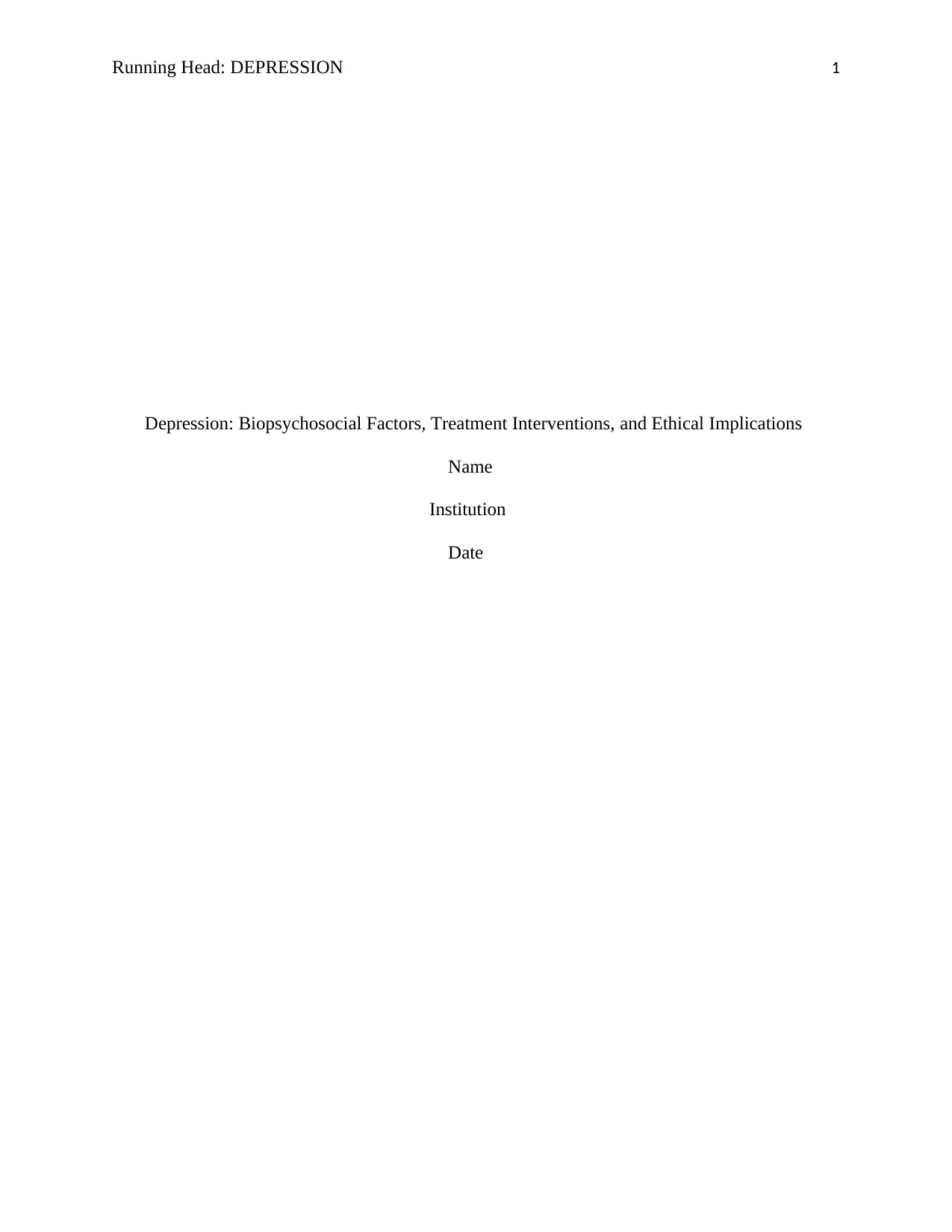
Running Head: DEPRESSION 1
Depression: Biopsychosocial Factors, Treatment Interventions, and Ethical Implications
Name
Institution
Date
Depression: Biopsychosocial Factors, Treatment Interventions, and Ethical Implications
Name
Institution
Date
Paraphrase This Document
Need a fresh take? Get an instant paraphrase of this document with our AI Paraphraser
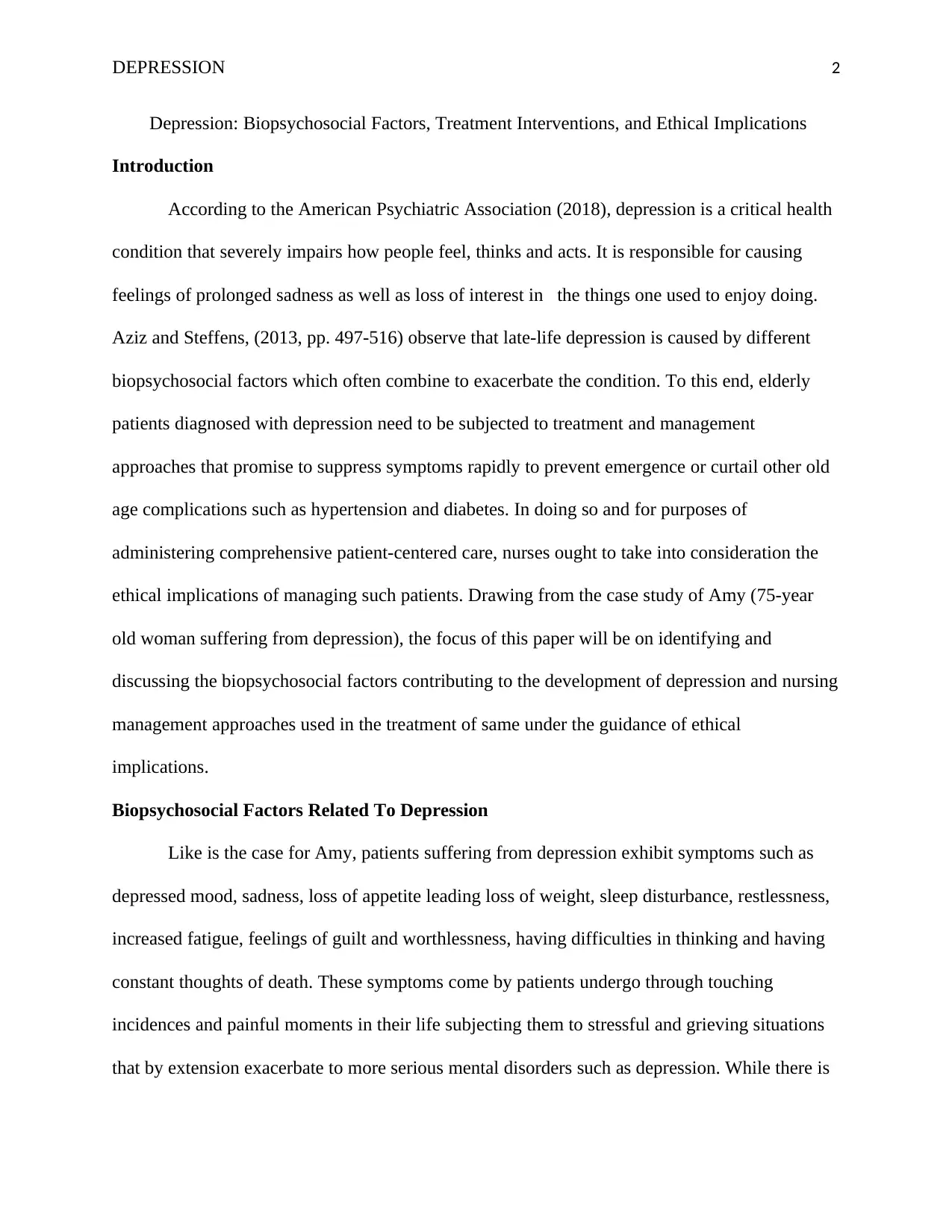
DEPRESSION 2
Depression: Biopsychosocial Factors, Treatment Interventions, and Ethical Implications
Introduction
According to the American Psychiatric Association (2018), depression is a critical health
condition that severely impairs how people feel, thinks and acts. It is responsible for causing
feelings of prolonged sadness as well as loss of interest in the things one used to enjoy doing.
Aziz and Steffens, (2013, pp. 497-516) observe that late-life depression is caused by different
biopsychosocial factors which often combine to exacerbate the condition. To this end, elderly
patients diagnosed with depression need to be subjected to treatment and management
approaches that promise to suppress symptoms rapidly to prevent emergence or curtail other old
age complications such as hypertension and diabetes. In doing so and for purposes of
administering comprehensive patient-centered care, nurses ought to take into consideration the
ethical implications of managing such patients. Drawing from the case study of Amy (75-year
old woman suffering from depression), the focus of this paper will be on identifying and
discussing the biopsychosocial factors contributing to the development of depression and nursing
management approaches used in the treatment of same under the guidance of ethical
implications.
Biopsychosocial Factors Related To Depression
Like is the case for Amy, patients suffering from depression exhibit symptoms such as
depressed mood, sadness, loss of appetite leading loss of weight, sleep disturbance, restlessness,
increased fatigue, feelings of guilt and worthlessness, having difficulties in thinking and having
constant thoughts of death. These symptoms come by patients undergo through touching
incidences and painful moments in their life subjecting them to stressful and grieving situations
that by extension exacerbate to more serious mental disorders such as depression. While there is
Depression: Biopsychosocial Factors, Treatment Interventions, and Ethical Implications
Introduction
According to the American Psychiatric Association (2018), depression is a critical health
condition that severely impairs how people feel, thinks and acts. It is responsible for causing
feelings of prolonged sadness as well as loss of interest in the things one used to enjoy doing.
Aziz and Steffens, (2013, pp. 497-516) observe that late-life depression is caused by different
biopsychosocial factors which often combine to exacerbate the condition. To this end, elderly
patients diagnosed with depression need to be subjected to treatment and management
approaches that promise to suppress symptoms rapidly to prevent emergence or curtail other old
age complications such as hypertension and diabetes. In doing so and for purposes of
administering comprehensive patient-centered care, nurses ought to take into consideration the
ethical implications of managing such patients. Drawing from the case study of Amy (75-year
old woman suffering from depression), the focus of this paper will be on identifying and
discussing the biopsychosocial factors contributing to the development of depression and nursing
management approaches used in the treatment of same under the guidance of ethical
implications.
Biopsychosocial Factors Related To Depression
Like is the case for Amy, patients suffering from depression exhibit symptoms such as
depressed mood, sadness, loss of appetite leading loss of weight, sleep disturbance, restlessness,
increased fatigue, feelings of guilt and worthlessness, having difficulties in thinking and having
constant thoughts of death. These symptoms come by patients undergo through touching
incidences and painful moments in their life subjecting them to stressful and grieving situations
that by extension exacerbate to more serious mental disorders such as depression. While there is
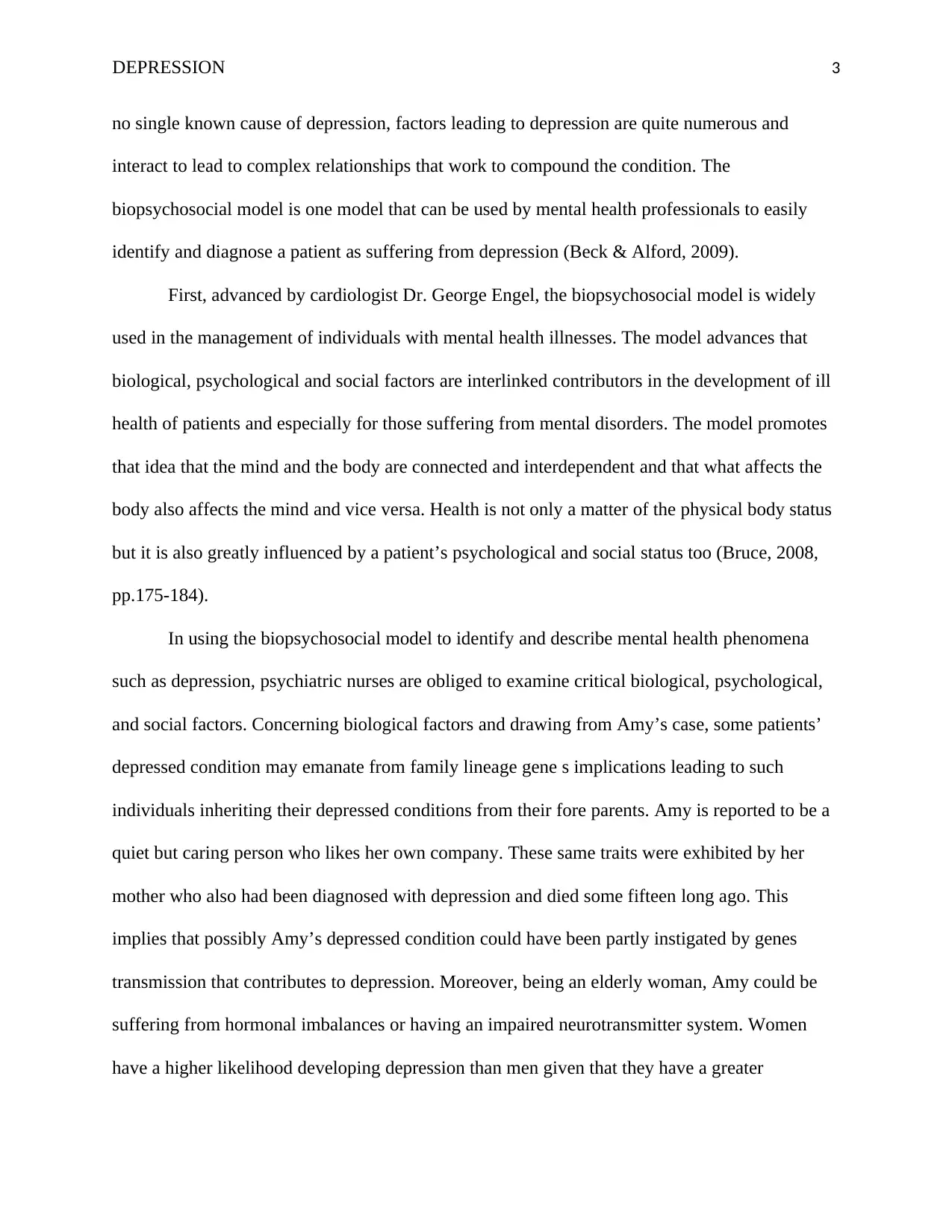
DEPRESSION 3
no single known cause of depression, factors leading to depression are quite numerous and
interact to lead to complex relationships that work to compound the condition. The
biopsychosocial model is one model that can be used by mental health professionals to easily
identify and diagnose a patient as suffering from depression (Beck & Alford, 2009).
First, advanced by cardiologist Dr. George Engel, the biopsychosocial model is widely
used in the management of individuals with mental health illnesses. The model advances that
biological, psychological and social factors are interlinked contributors in the development of ill
health of patients and especially for those suffering from mental disorders. The model promotes
that idea that the mind and the body are connected and interdependent and that what affects the
body also affects the mind and vice versa. Health is not only a matter of the physical body status
but it is also greatly influenced by a patient’s psychological and social status too (Bruce, 2008,
pp.175-184).
In using the biopsychosocial model to identify and describe mental health phenomena
such as depression, psychiatric nurses are obliged to examine critical biological, psychological,
and social factors. Concerning biological factors and drawing from Amy’s case, some patients’
depressed condition may emanate from family lineage gene s implications leading to such
individuals inheriting their depressed conditions from their fore parents. Amy is reported to be a
quiet but caring person who likes her own company. These same traits were exhibited by her
mother who also had been diagnosed with depression and died some fifteen long ago. This
implies that possibly Amy’s depressed condition could have been partly instigated by genes
transmission that contributes to depression. Moreover, being an elderly woman, Amy could be
suffering from hormonal imbalances or having an impaired neurotransmitter system. Women
have a higher likelihood developing depression than men given that they have a greater
no single known cause of depression, factors leading to depression are quite numerous and
interact to lead to complex relationships that work to compound the condition. The
biopsychosocial model is one model that can be used by mental health professionals to easily
identify and diagnose a patient as suffering from depression (Beck & Alford, 2009).
First, advanced by cardiologist Dr. George Engel, the biopsychosocial model is widely
used in the management of individuals with mental health illnesses. The model advances that
biological, psychological and social factors are interlinked contributors in the development of ill
health of patients and especially for those suffering from mental disorders. The model promotes
that idea that the mind and the body are connected and interdependent and that what affects the
body also affects the mind and vice versa. Health is not only a matter of the physical body status
but it is also greatly influenced by a patient’s psychological and social status too (Bruce, 2008,
pp.175-184).
In using the biopsychosocial model to identify and describe mental health phenomena
such as depression, psychiatric nurses are obliged to examine critical biological, psychological,
and social factors. Concerning biological factors and drawing from Amy’s case, some patients’
depressed condition may emanate from family lineage gene s implications leading to such
individuals inheriting their depressed conditions from their fore parents. Amy is reported to be a
quiet but caring person who likes her own company. These same traits were exhibited by her
mother who also had been diagnosed with depression and died some fifteen long ago. This
implies that possibly Amy’s depressed condition could have been partly instigated by genes
transmission that contributes to depression. Moreover, being an elderly woman, Amy could be
suffering from hormonal imbalances or having an impaired neurotransmitter system. Women
have a higher likelihood developing depression than men given that they have a greater
⊘ This is a preview!⊘
Do you want full access?
Subscribe today to unlock all pages.

Trusted by 1+ million students worldwide
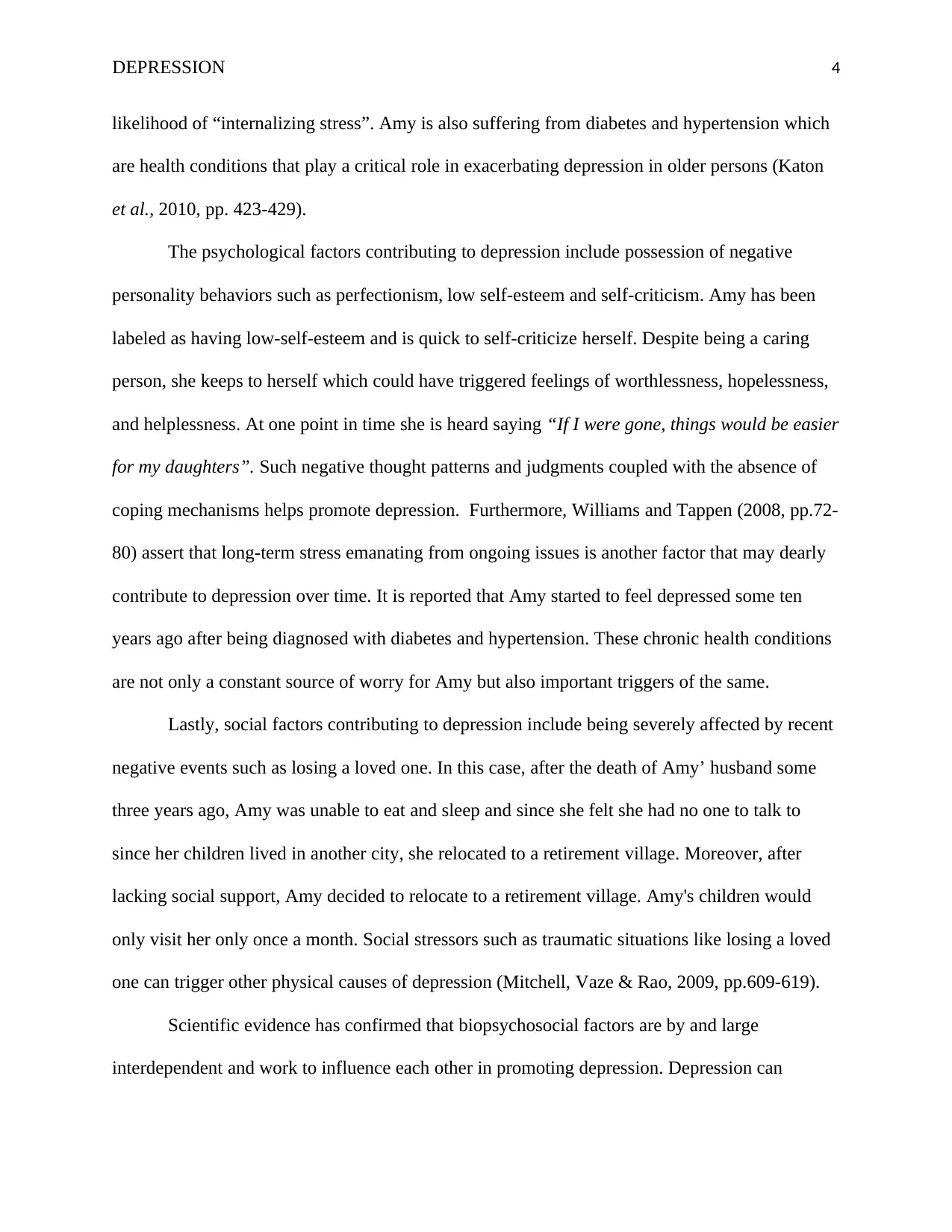
DEPRESSION 4
likelihood of “internalizing stress”. Amy is also suffering from diabetes and hypertension which
are health conditions that play a critical role in exacerbating depression in older persons (Katon
et al., 2010, pp. 423-429).
The psychological factors contributing to depression include possession of negative
personality behaviors such as perfectionism, low self-esteem and self-criticism. Amy has been
labeled as having low-self-esteem and is quick to self-criticize herself. Despite being a caring
person, she keeps to herself which could have triggered feelings of worthlessness, hopelessness,
and helplessness. At one point in time she is heard saying “If I were gone, things would be easier
for my daughters”. Such negative thought patterns and judgments coupled with the absence of
coping mechanisms helps promote depression. Furthermore, Williams and Tappen (2008, pp.72-
80) assert that long-term stress emanating from ongoing issues is another factor that may dearly
contribute to depression over time. It is reported that Amy started to feel depressed some ten
years ago after being diagnosed with diabetes and hypertension. These chronic health conditions
are not only a constant source of worry for Amy but also important triggers of the same.
Lastly, social factors contributing to depression include being severely affected by recent
negative events such as losing a loved one. In this case, after the death of Amy’ husband some
three years ago, Amy was unable to eat and sleep and since she felt she had no one to talk to
since her children lived in another city, she relocated to a retirement village. Moreover, after
lacking social support, Amy decided to relocate to a retirement village. Amy's children would
only visit her only once a month. Social stressors such as traumatic situations like losing a loved
one can trigger other physical causes of depression (Mitchell, Vaze & Rao, 2009, pp.609-619).
Scientific evidence has confirmed that biopsychosocial factors are by and large
interdependent and work to influence each other in promoting depression. Depression can
likelihood of “internalizing stress”. Amy is also suffering from diabetes and hypertension which
are health conditions that play a critical role in exacerbating depression in older persons (Katon
et al., 2010, pp. 423-429).
The psychological factors contributing to depression include possession of negative
personality behaviors such as perfectionism, low self-esteem and self-criticism. Amy has been
labeled as having low-self-esteem and is quick to self-criticize herself. Despite being a caring
person, she keeps to herself which could have triggered feelings of worthlessness, hopelessness,
and helplessness. At one point in time she is heard saying “If I were gone, things would be easier
for my daughters”. Such negative thought patterns and judgments coupled with the absence of
coping mechanisms helps promote depression. Furthermore, Williams and Tappen (2008, pp.72-
80) assert that long-term stress emanating from ongoing issues is another factor that may dearly
contribute to depression over time. It is reported that Amy started to feel depressed some ten
years ago after being diagnosed with diabetes and hypertension. These chronic health conditions
are not only a constant source of worry for Amy but also important triggers of the same.
Lastly, social factors contributing to depression include being severely affected by recent
negative events such as losing a loved one. In this case, after the death of Amy’ husband some
three years ago, Amy was unable to eat and sleep and since she felt she had no one to talk to
since her children lived in another city, she relocated to a retirement village. Moreover, after
lacking social support, Amy decided to relocate to a retirement village. Amy's children would
only visit her only once a month. Social stressors such as traumatic situations like losing a loved
one can trigger other physical causes of depression (Mitchell, Vaze & Rao, 2009, pp.609-619).
Scientific evidence has confirmed that biopsychosocial factors are by and large
interdependent and work to influence each other in promoting depression. Depression can
Paraphrase This Document
Need a fresh take? Get an instant paraphrase of this document with our AI Paraphraser
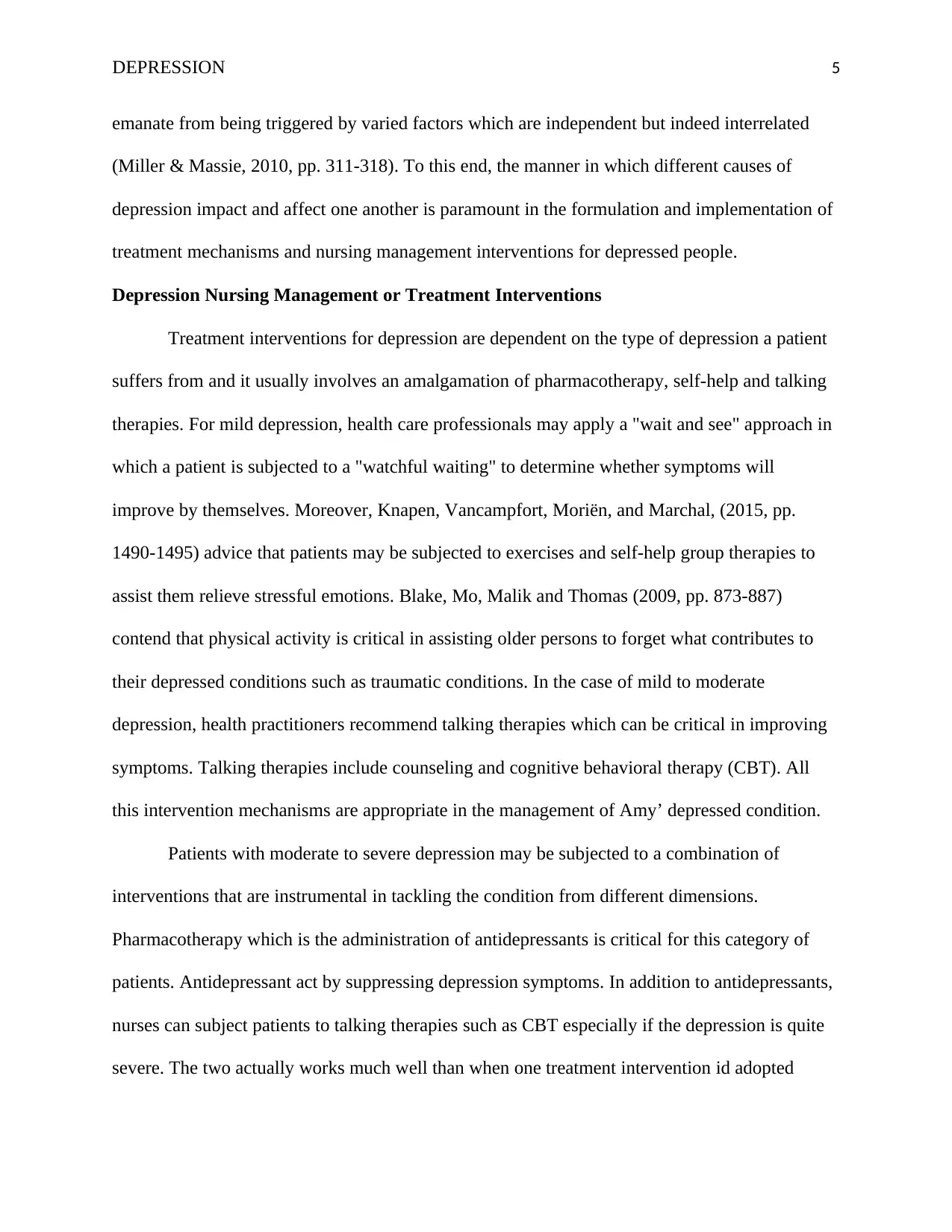
DEPRESSION 5
emanate from being triggered by varied factors which are independent but indeed interrelated
(Miller & Massie, 2010, pp. 311-318). To this end, the manner in which different causes of
depression impact and affect one another is paramount in the formulation and implementation of
treatment mechanisms and nursing management interventions for depressed people.
Depression Nursing Management or Treatment Interventions
Treatment interventions for depression are dependent on the type of depression a patient
suffers from and it usually involves an amalgamation of pharmacotherapy, self-help and talking
therapies. For mild depression, health care professionals may apply a "wait and see" approach in
which a patient is subjected to a "watchful waiting" to determine whether symptoms will
improve by themselves. Moreover, Knapen, Vancampfort, Moriën, and Marchal, (2015, pp.
1490-1495) advice that patients may be subjected to exercises and self-help group therapies to
assist them relieve stressful emotions. Blake, Mo, Malik and Thomas (2009, pp. 873-887)
contend that physical activity is critical in assisting older persons to forget what contributes to
their depressed conditions such as traumatic conditions. In the case of mild to moderate
depression, health practitioners recommend talking therapies which can be critical in improving
symptoms. Talking therapies include counseling and cognitive behavioral therapy (CBT). All
this intervention mechanisms are appropriate in the management of Amy’ depressed condition.
Patients with moderate to severe depression may be subjected to a combination of
interventions that are instrumental in tackling the condition from different dimensions.
Pharmacotherapy which is the administration of antidepressants is critical for this category of
patients. Antidepressant act by suppressing depression symptoms. In addition to antidepressants,
nurses can subject patients to talking therapies such as CBT especially if the depression is quite
severe. The two actually works much well than when one treatment intervention id adopted
emanate from being triggered by varied factors which are independent but indeed interrelated
(Miller & Massie, 2010, pp. 311-318). To this end, the manner in which different causes of
depression impact and affect one another is paramount in the formulation and implementation of
treatment mechanisms and nursing management interventions for depressed people.
Depression Nursing Management or Treatment Interventions
Treatment interventions for depression are dependent on the type of depression a patient
suffers from and it usually involves an amalgamation of pharmacotherapy, self-help and talking
therapies. For mild depression, health care professionals may apply a "wait and see" approach in
which a patient is subjected to a "watchful waiting" to determine whether symptoms will
improve by themselves. Moreover, Knapen, Vancampfort, Moriën, and Marchal, (2015, pp.
1490-1495) advice that patients may be subjected to exercises and self-help group therapies to
assist them relieve stressful emotions. Blake, Mo, Malik and Thomas (2009, pp. 873-887)
contend that physical activity is critical in assisting older persons to forget what contributes to
their depressed conditions such as traumatic conditions. In the case of mild to moderate
depression, health practitioners recommend talking therapies which can be critical in improving
symptoms. Talking therapies include counseling and cognitive behavioral therapy (CBT). All
this intervention mechanisms are appropriate in the management of Amy’ depressed condition.
Patients with moderate to severe depression may be subjected to a combination of
interventions that are instrumental in tackling the condition from different dimensions.
Pharmacotherapy which is the administration of antidepressants is critical for this category of
patients. Antidepressant act by suppressing depression symptoms. In addition to antidepressants,
nurses can subject patients to talking therapies such as CBT especially if the depression is quite
severe. The two actually works much well than when one treatment intervention id adopted
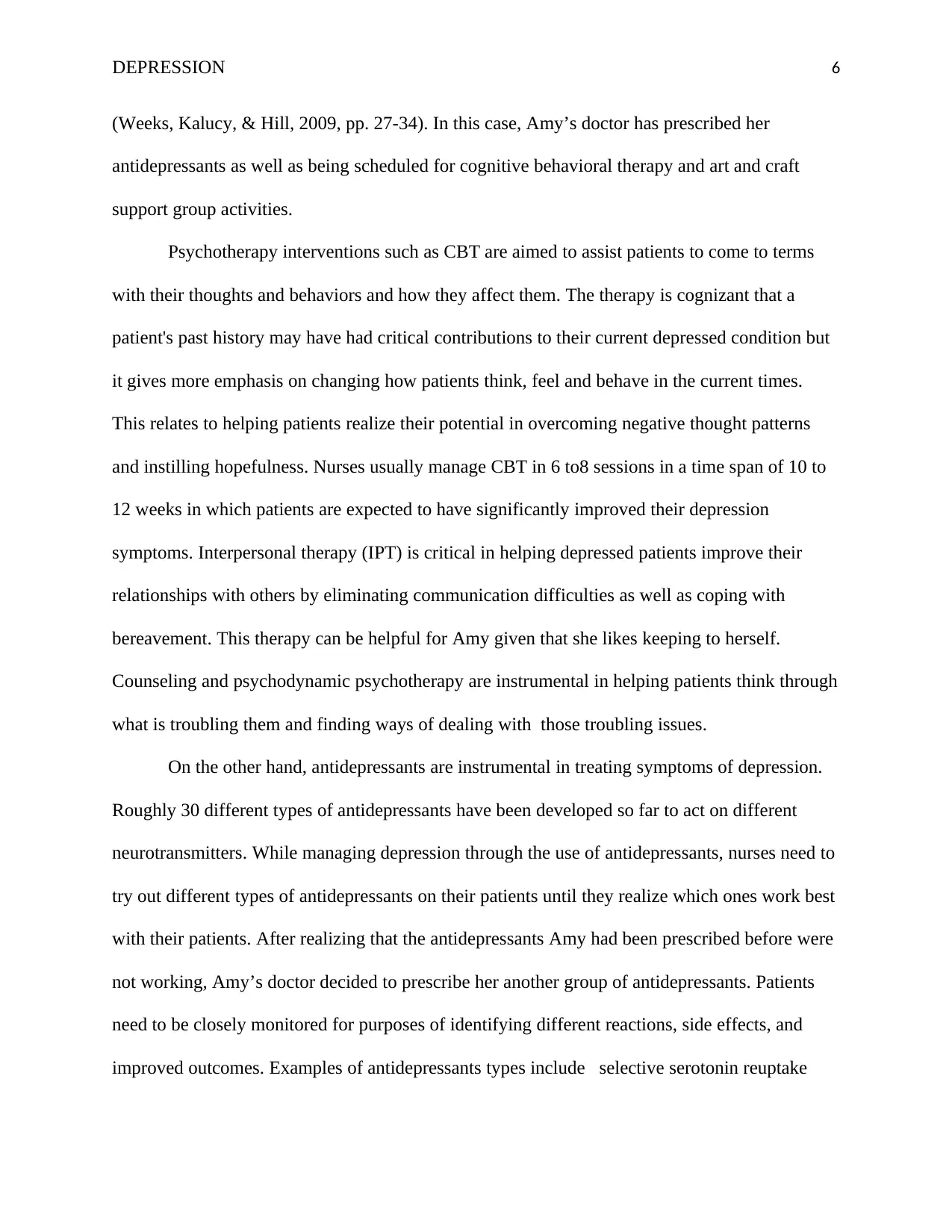
DEPRESSION 6
(Weeks, Kalucy, & Hill, 2009, pp. 27-34). In this case, Amy’s doctor has prescribed her
antidepressants as well as being scheduled for cognitive behavioral therapy and art and craft
support group activities.
Psychotherapy interventions such as CBT are aimed to assist patients to come to terms
with their thoughts and behaviors and how they affect them. The therapy is cognizant that a
patient's past history may have had critical contributions to their current depressed condition but
it gives more emphasis on changing how patients think, feel and behave in the current times.
This relates to helping patients realize their potential in overcoming negative thought patterns
and instilling hopefulness. Nurses usually manage CBT in 6 to8 sessions in a time span of 10 to
12 weeks in which patients are expected to have significantly improved their depression
symptoms. Interpersonal therapy (IPT) is critical in helping depressed patients improve their
relationships with others by eliminating communication difficulties as well as coping with
bereavement. This therapy can be helpful for Amy given that she likes keeping to herself.
Counseling and psychodynamic psychotherapy are instrumental in helping patients think through
what is troubling them and finding ways of dealing with those troubling issues.
On the other hand, antidepressants are instrumental in treating symptoms of depression.
Roughly 30 different types of antidepressants have been developed so far to act on different
neurotransmitters. While managing depression through the use of antidepressants, nurses need to
try out different types of antidepressants on their patients until they realize which ones work best
with their patients. After realizing that the antidepressants Amy had been prescribed before were
not working, Amy’s doctor decided to prescribe her another group of antidepressants. Patients
need to be closely monitored for purposes of identifying different reactions, side effects, and
improved outcomes. Examples of antidepressants types include selective serotonin reuptake
(Weeks, Kalucy, & Hill, 2009, pp. 27-34). In this case, Amy’s doctor has prescribed her
antidepressants as well as being scheduled for cognitive behavioral therapy and art and craft
support group activities.
Psychotherapy interventions such as CBT are aimed to assist patients to come to terms
with their thoughts and behaviors and how they affect them. The therapy is cognizant that a
patient's past history may have had critical contributions to their current depressed condition but
it gives more emphasis on changing how patients think, feel and behave in the current times.
This relates to helping patients realize their potential in overcoming negative thought patterns
and instilling hopefulness. Nurses usually manage CBT in 6 to8 sessions in a time span of 10 to
12 weeks in which patients are expected to have significantly improved their depression
symptoms. Interpersonal therapy (IPT) is critical in helping depressed patients improve their
relationships with others by eliminating communication difficulties as well as coping with
bereavement. This therapy can be helpful for Amy given that she likes keeping to herself.
Counseling and psychodynamic psychotherapy are instrumental in helping patients think through
what is troubling them and finding ways of dealing with those troubling issues.
On the other hand, antidepressants are instrumental in treating symptoms of depression.
Roughly 30 different types of antidepressants have been developed so far to act on different
neurotransmitters. While managing depression through the use of antidepressants, nurses need to
try out different types of antidepressants on their patients until they realize which ones work best
with their patients. After realizing that the antidepressants Amy had been prescribed before were
not working, Amy’s doctor decided to prescribe her another group of antidepressants. Patients
need to be closely monitored for purposes of identifying different reactions, side effects, and
improved outcomes. Examples of antidepressants types include selective serotonin reuptake
⊘ This is a preview!⊘
Do you want full access?
Subscribe today to unlock all pages.

Trusted by 1+ million students worldwide
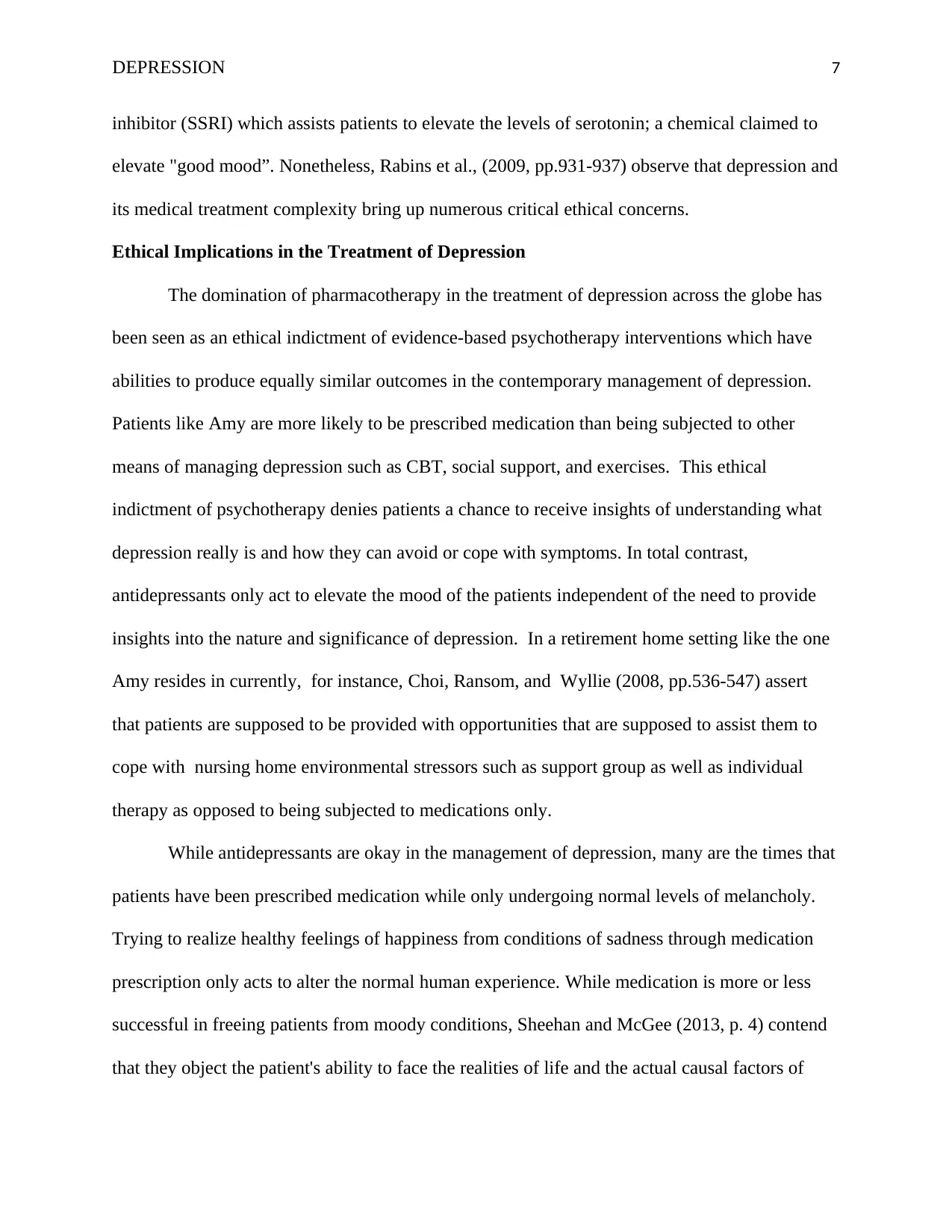
DEPRESSION 7
inhibitor (SSRI) which assists patients to elevate the levels of serotonin; a chemical claimed to
elevate "good mood”. Nonetheless, Rabins et al., (2009, pp.931-937) observe that depression and
its medical treatment complexity bring up numerous critical ethical concerns.
Ethical Implications in the Treatment of Depression
The domination of pharmacotherapy in the treatment of depression across the globe has
been seen as an ethical indictment of evidence-based psychotherapy interventions which have
abilities to produce equally similar outcomes in the contemporary management of depression.
Patients like Amy are more likely to be prescribed medication than being subjected to other
means of managing depression such as CBT, social support, and exercises. This ethical
indictment of psychotherapy denies patients a chance to receive insights of understanding what
depression really is and how they can avoid or cope with symptoms. In total contrast,
antidepressants only act to elevate the mood of the patients independent of the need to provide
insights into the nature and significance of depression. In a retirement home setting like the one
Amy resides in currently, for instance, Choi, Ransom, and Wyllie (2008, pp.536-547) assert
that patients are supposed to be provided with opportunities that are supposed to assist them to
cope with nursing home environmental stressors such as support group as well as individual
therapy as opposed to being subjected to medications only.
While antidepressants are okay in the management of depression, many are the times that
patients have been prescribed medication while only undergoing normal levels of melancholy.
Trying to realize healthy feelings of happiness from conditions of sadness through medication
prescription only acts to alter the normal human experience. While medication is more or less
successful in freeing patients from moody conditions, Sheehan and McGee (2013, p. 4) contend
that they object the patient's ability to face the realities of life and the actual causal factors of
inhibitor (SSRI) which assists patients to elevate the levels of serotonin; a chemical claimed to
elevate "good mood”. Nonetheless, Rabins et al., (2009, pp.931-937) observe that depression and
its medical treatment complexity bring up numerous critical ethical concerns.
Ethical Implications in the Treatment of Depression
The domination of pharmacotherapy in the treatment of depression across the globe has
been seen as an ethical indictment of evidence-based psychotherapy interventions which have
abilities to produce equally similar outcomes in the contemporary management of depression.
Patients like Amy are more likely to be prescribed medication than being subjected to other
means of managing depression such as CBT, social support, and exercises. This ethical
indictment of psychotherapy denies patients a chance to receive insights of understanding what
depression really is and how they can avoid or cope with symptoms. In total contrast,
antidepressants only act to elevate the mood of the patients independent of the need to provide
insights into the nature and significance of depression. In a retirement home setting like the one
Amy resides in currently, for instance, Choi, Ransom, and Wyllie (2008, pp.536-547) assert
that patients are supposed to be provided with opportunities that are supposed to assist them to
cope with nursing home environmental stressors such as support group as well as individual
therapy as opposed to being subjected to medications only.
While antidepressants are okay in the management of depression, many are the times that
patients have been prescribed medication while only undergoing normal levels of melancholy.
Trying to realize healthy feelings of happiness from conditions of sadness through medication
prescription only acts to alter the normal human experience. While medication is more or less
successful in freeing patients from moody conditions, Sheehan and McGee (2013, p. 4) contend
that they object the patient's ability to face the realities of life and the actual causal factors of
Paraphrase This Document
Need a fresh take? Get an instant paraphrase of this document with our AI Paraphraser
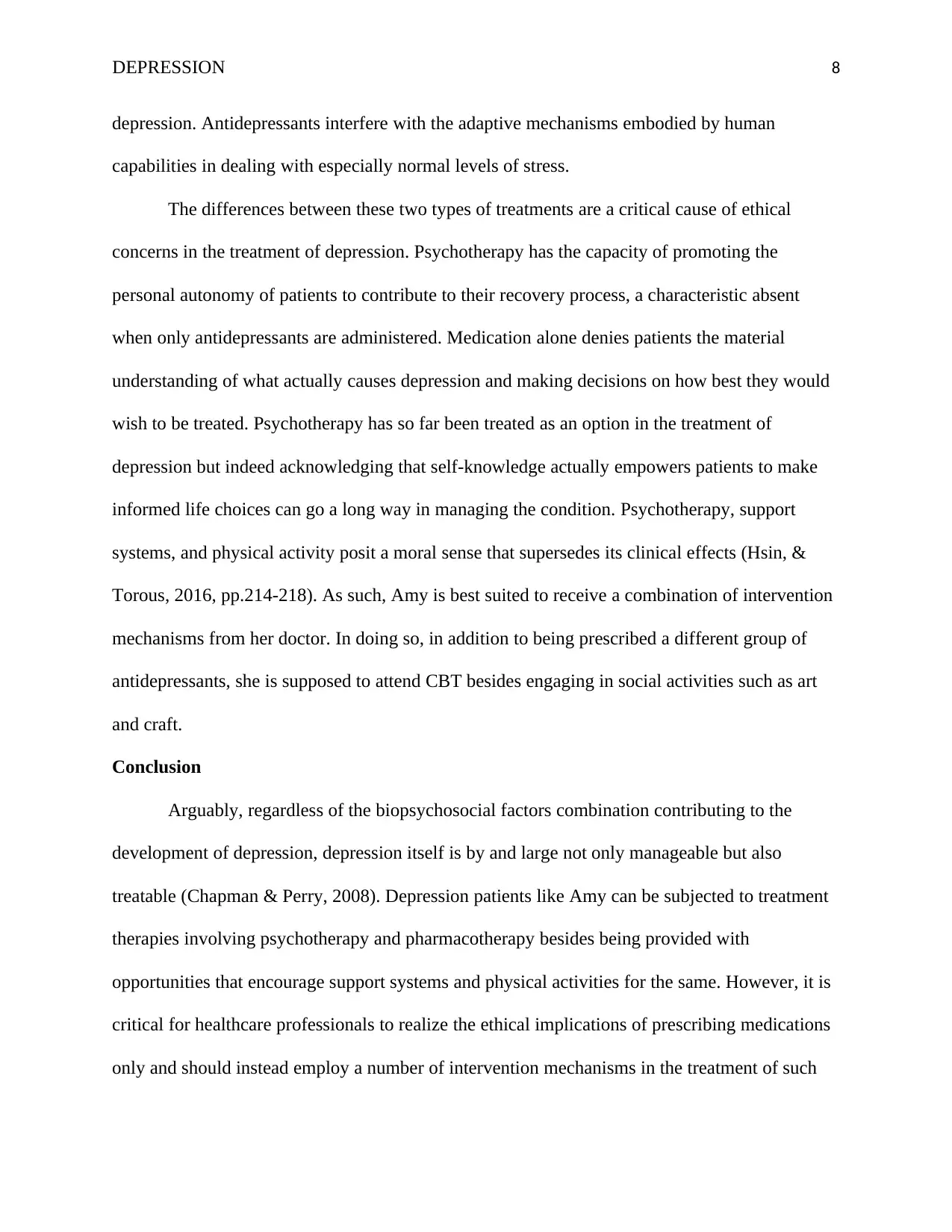
DEPRESSION 8
depression. Antidepressants interfere with the adaptive mechanisms embodied by human
capabilities in dealing with especially normal levels of stress.
The differences between these two types of treatments are a critical cause of ethical
concerns in the treatment of depression. Psychotherapy has the capacity of promoting the
personal autonomy of patients to contribute to their recovery process, a characteristic absent
when only antidepressants are administered. Medication alone denies patients the material
understanding of what actually causes depression and making decisions on how best they would
wish to be treated. Psychotherapy has so far been treated as an option in the treatment of
depression but indeed acknowledging that self-knowledge actually empowers patients to make
informed life choices can go a long way in managing the condition. Psychotherapy, support
systems, and physical activity posit a moral sense that supersedes its clinical effects (Hsin, &
Torous, 2016, pp.214-218). As such, Amy is best suited to receive a combination of intervention
mechanisms from her doctor. In doing so, in addition to being prescribed a different group of
antidepressants, she is supposed to attend CBT besides engaging in social activities such as art
and craft.
Conclusion
Arguably, regardless of the biopsychosocial factors combination contributing to the
development of depression, depression itself is by and large not only manageable but also
treatable (Chapman & Perry, 2008). Depression patients like Amy can be subjected to treatment
therapies involving psychotherapy and pharmacotherapy besides being provided with
opportunities that encourage support systems and physical activities for the same. However, it is
critical for healthcare professionals to realize the ethical implications of prescribing medications
only and should instead employ a number of intervention mechanisms in the treatment of such
depression. Antidepressants interfere with the adaptive mechanisms embodied by human
capabilities in dealing with especially normal levels of stress.
The differences between these two types of treatments are a critical cause of ethical
concerns in the treatment of depression. Psychotherapy has the capacity of promoting the
personal autonomy of patients to contribute to their recovery process, a characteristic absent
when only antidepressants are administered. Medication alone denies patients the material
understanding of what actually causes depression and making decisions on how best they would
wish to be treated. Psychotherapy has so far been treated as an option in the treatment of
depression but indeed acknowledging that self-knowledge actually empowers patients to make
informed life choices can go a long way in managing the condition. Psychotherapy, support
systems, and physical activity posit a moral sense that supersedes its clinical effects (Hsin, &
Torous, 2016, pp.214-218). As such, Amy is best suited to receive a combination of intervention
mechanisms from her doctor. In doing so, in addition to being prescribed a different group of
antidepressants, she is supposed to attend CBT besides engaging in social activities such as art
and craft.
Conclusion
Arguably, regardless of the biopsychosocial factors combination contributing to the
development of depression, depression itself is by and large not only manageable but also
treatable (Chapman & Perry, 2008). Depression patients like Amy can be subjected to treatment
therapies involving psychotherapy and pharmacotherapy besides being provided with
opportunities that encourage support systems and physical activities for the same. However, it is
critical for healthcare professionals to realize the ethical implications of prescribing medications
only and should instead employ a number of intervention mechanisms in the treatment of such
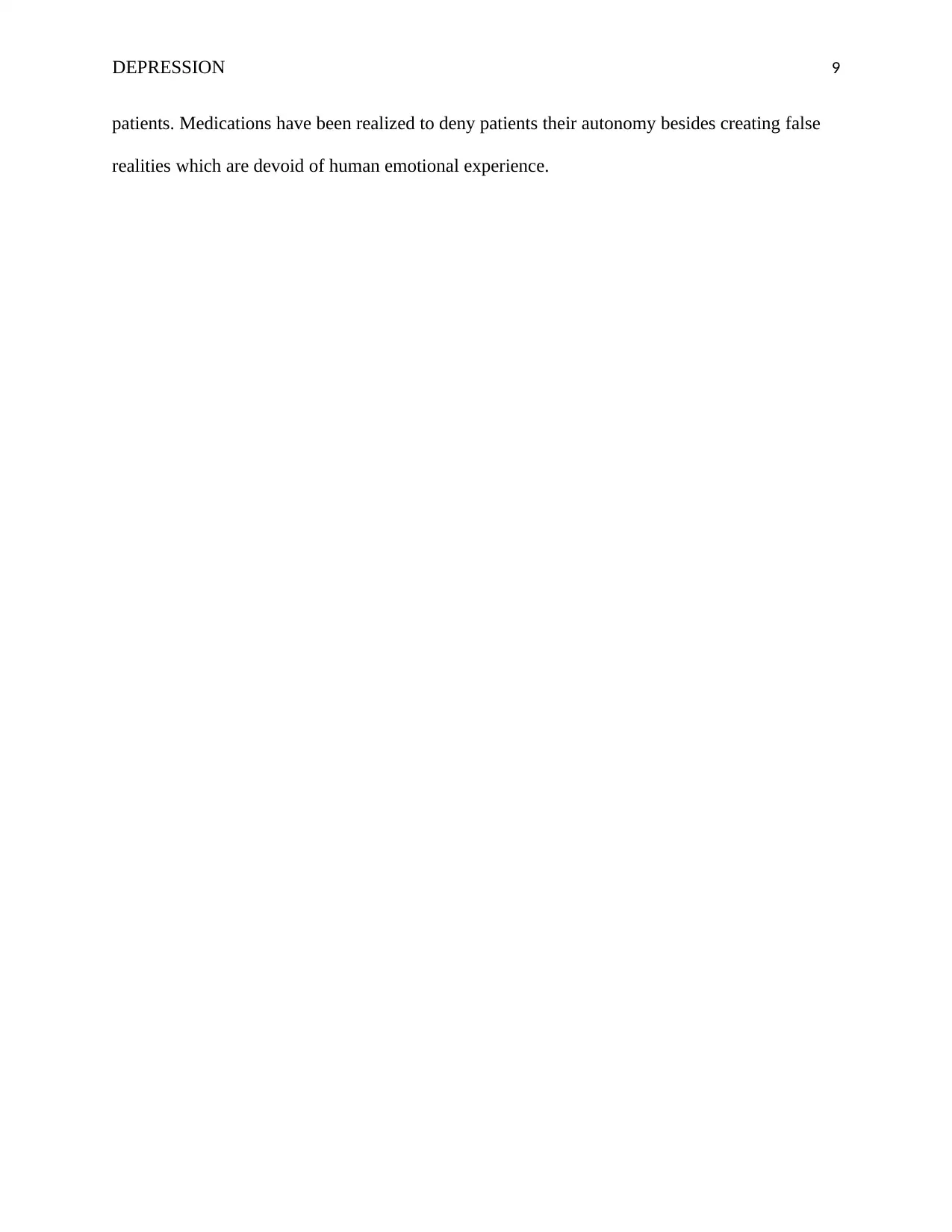
DEPRESSION 9
patients. Medications have been realized to deny patients their autonomy besides creating false
realities which are devoid of human emotional experience.
patients. Medications have been realized to deny patients their autonomy besides creating false
realities which are devoid of human emotional experience.
⊘ This is a preview!⊘
Do you want full access?
Subscribe today to unlock all pages.

Trusted by 1+ million students worldwide
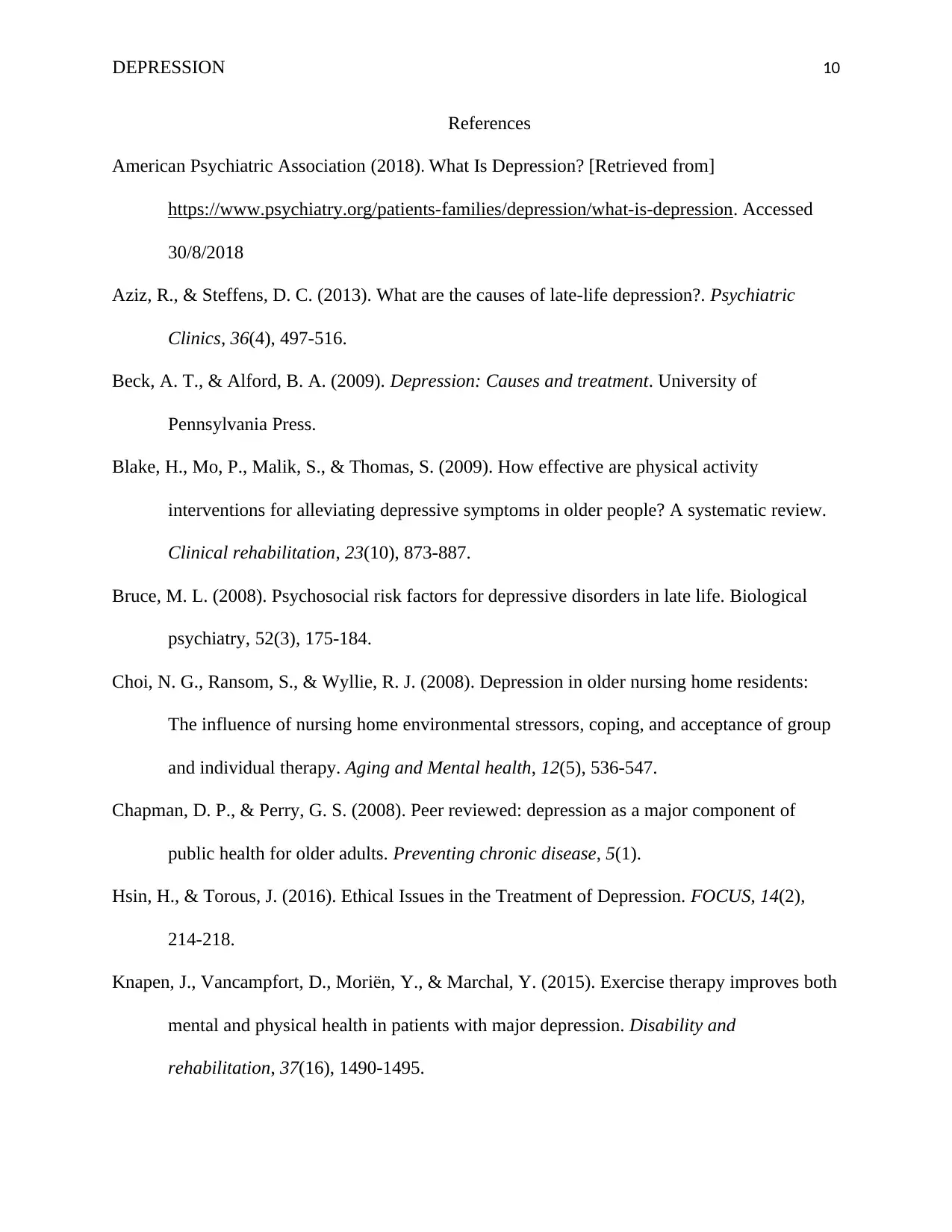
DEPRESSION 10
References
American Psychiatric Association (2018). What Is Depression? [Retrieved from]
https://www.psychiatry.org/patients-families/depression/what-is-depression. Accessed
30/8/2018
Aziz, R., & Steffens, D. C. (2013). What are the causes of late-life depression?. Psychiatric
Clinics, 36(4), 497-516.
Beck, A. T., & Alford, B. A. (2009). Depression: Causes and treatment. University of
Pennsylvania Press.
Blake, H., Mo, P., Malik, S., & Thomas, S. (2009). How effective are physical activity
interventions for alleviating depressive symptoms in older people? A systematic review.
Clinical rehabilitation, 23(10), 873-887.
Bruce, M. L. (2008). Psychosocial risk factors for depressive disorders in late life. Biological
psychiatry, 52(3), 175-184.
Choi, N. G., Ransom, S., & Wyllie, R. J. (2008). Depression in older nursing home residents:
The influence of nursing home environmental stressors, coping, and acceptance of group
and individual therapy. Aging and Mental health, 12(5), 536-547.
Chapman, D. P., & Perry, G. S. (2008). Peer reviewed: depression as a major component of
public health for older adults. Preventing chronic disease, 5(1).
Hsin, H., & Torous, J. (2016). Ethical Issues in the Treatment of Depression. FOCUS, 14(2),
214-218.
Knapen, J., Vancampfort, D., Moriën, Y., & Marchal, Y. (2015). Exercise therapy improves both
mental and physical health in patients with major depression. Disability and
rehabilitation, 37(16), 1490-1495.
References
American Psychiatric Association (2018). What Is Depression? [Retrieved from]
https://www.psychiatry.org/patients-families/depression/what-is-depression. Accessed
30/8/2018
Aziz, R., & Steffens, D. C. (2013). What are the causes of late-life depression?. Psychiatric
Clinics, 36(4), 497-516.
Beck, A. T., & Alford, B. A. (2009). Depression: Causes and treatment. University of
Pennsylvania Press.
Blake, H., Mo, P., Malik, S., & Thomas, S. (2009). How effective are physical activity
interventions for alleviating depressive symptoms in older people? A systematic review.
Clinical rehabilitation, 23(10), 873-887.
Bruce, M. L. (2008). Psychosocial risk factors for depressive disorders in late life. Biological
psychiatry, 52(3), 175-184.
Choi, N. G., Ransom, S., & Wyllie, R. J. (2008). Depression in older nursing home residents:
The influence of nursing home environmental stressors, coping, and acceptance of group
and individual therapy. Aging and Mental health, 12(5), 536-547.
Chapman, D. P., & Perry, G. S. (2008). Peer reviewed: depression as a major component of
public health for older adults. Preventing chronic disease, 5(1).
Hsin, H., & Torous, J. (2016). Ethical Issues in the Treatment of Depression. FOCUS, 14(2),
214-218.
Knapen, J., Vancampfort, D., Moriën, Y., & Marchal, Y. (2015). Exercise therapy improves both
mental and physical health in patients with major depression. Disability and
rehabilitation, 37(16), 1490-1495.
Paraphrase This Document
Need a fresh take? Get an instant paraphrase of this document with our AI Paraphraser
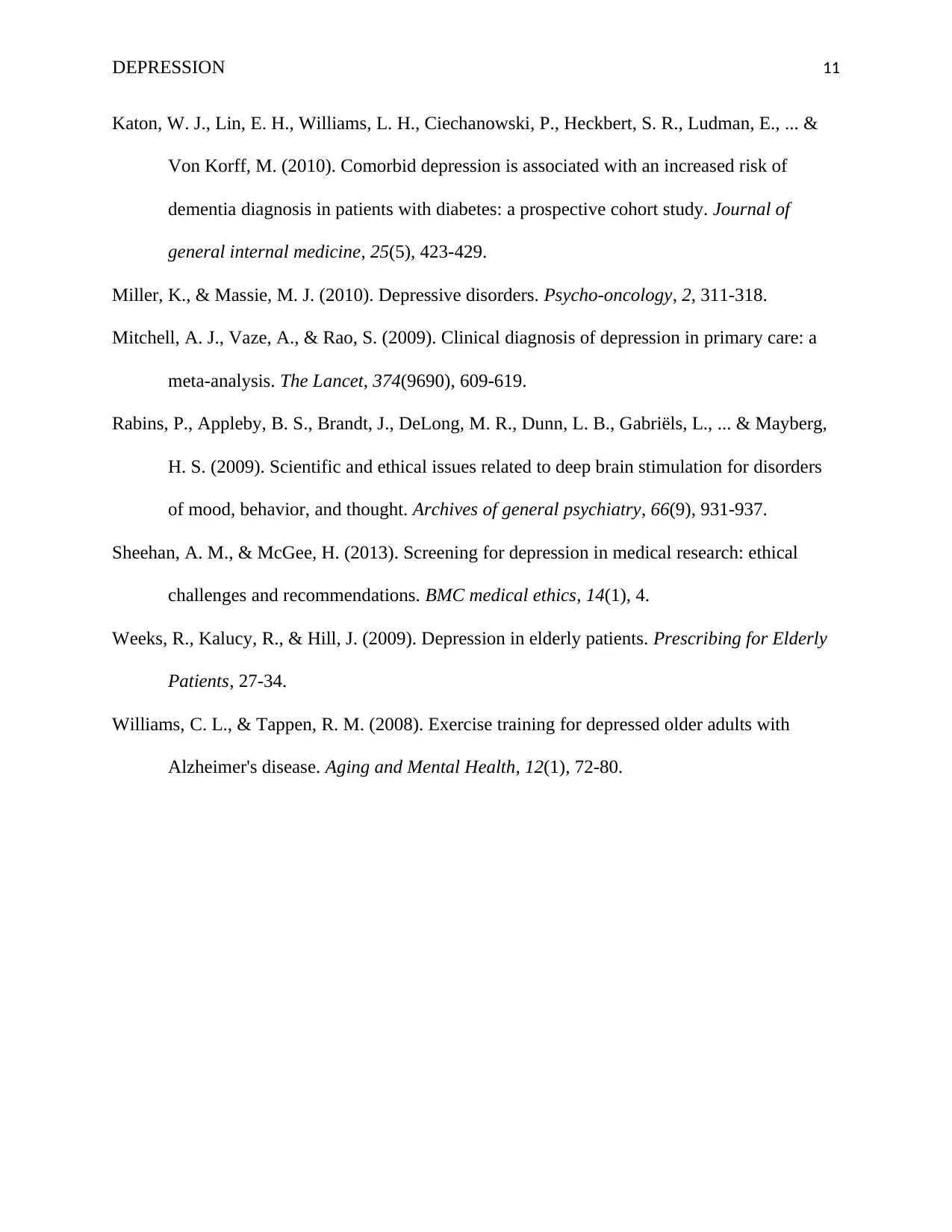
DEPRESSION 11
Katon, W. J., Lin, E. H., Williams, L. H., Ciechanowski, P., Heckbert, S. R., Ludman, E., ... &
Von Korff, M. (2010). Comorbid depression is associated with an increased risk of
dementia diagnosis in patients with diabetes: a prospective cohort study. Journal of
general internal medicine, 25(5), 423-429.
Miller, K., & Massie, M. J. (2010). Depressive disorders. Psycho-oncology, 2, 311-318.
Mitchell, A. J., Vaze, A., & Rao, S. (2009). Clinical diagnosis of depression in primary care: a
meta-analysis. The Lancet, 374(9690), 609-619.
Rabins, P., Appleby, B. S., Brandt, J., DeLong, M. R., Dunn, L. B., Gabriëls, L., ... & Mayberg,
H. S. (2009). Scientific and ethical issues related to deep brain stimulation for disorders
of mood, behavior, and thought. Archives of general psychiatry, 66(9), 931-937.
Sheehan, A. M., & McGee, H. (2013). Screening for depression in medical research: ethical
challenges and recommendations. BMC medical ethics, 14(1), 4.
Weeks, R., Kalucy, R., & Hill, J. (2009). Depression in elderly patients. Prescribing for Elderly
Patients, 27-34.
Williams, C. L., & Tappen, R. M. (2008). Exercise training for depressed older adults with
Alzheimer's disease. Aging and Mental Health, 12(1), 72-80.
Katon, W. J., Lin, E. H., Williams, L. H., Ciechanowski, P., Heckbert, S. R., Ludman, E., ... &
Von Korff, M. (2010). Comorbid depression is associated with an increased risk of
dementia diagnosis in patients with diabetes: a prospective cohort study. Journal of
general internal medicine, 25(5), 423-429.
Miller, K., & Massie, M. J. (2010). Depressive disorders. Psycho-oncology, 2, 311-318.
Mitchell, A. J., Vaze, A., & Rao, S. (2009). Clinical diagnosis of depression in primary care: a
meta-analysis. The Lancet, 374(9690), 609-619.
Rabins, P., Appleby, B. S., Brandt, J., DeLong, M. R., Dunn, L. B., Gabriëls, L., ... & Mayberg,
H. S. (2009). Scientific and ethical issues related to deep brain stimulation for disorders
of mood, behavior, and thought. Archives of general psychiatry, 66(9), 931-937.
Sheehan, A. M., & McGee, H. (2013). Screening for depression in medical research: ethical
challenges and recommendations. BMC medical ethics, 14(1), 4.
Weeks, R., Kalucy, R., & Hill, J. (2009). Depression in elderly patients. Prescribing for Elderly
Patients, 27-34.
Williams, C. L., & Tappen, R. M. (2008). Exercise training for depressed older adults with
Alzheimer's disease. Aging and Mental Health, 12(1), 72-80.
1 out of 11
Related Documents
Your All-in-One AI-Powered Toolkit for Academic Success.
+13062052269
info@desklib.com
Available 24*7 on WhatsApp / Email
![[object Object]](/_next/static/media/star-bottom.7253800d.svg)
Unlock your academic potential
Copyright © 2020–2025 A2Z Services. All Rights Reserved. Developed and managed by ZUCOL.





